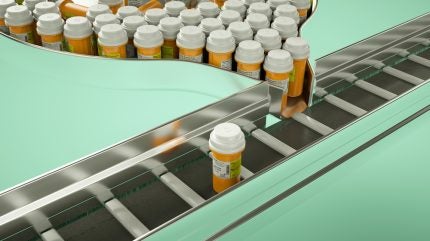
Counterfeit drug production and distribution has increased in recent years. Disruption from the Covid-19 pandemic, business resilience impacts, and rapid technological development have prompted a wave of fake medications entering various pharmaceutical supply chain phases (PSC).
For example, the recent surge in counterfeit weight loss drugs has raised serious concerns in Europe.
Drug shortages are also prevalent in today’s sector due to manufacturing problems, quality issues, delays, and discontinuations, the US Food and Drug Administration (FDA) reported. “Valuable, life-saving therapies are not reaching patients in need on time,” Sreedhar Patnala, general manager at Systech, a digital identification and traceability solutions provider, tells Pharmaceutical Technology.
With accessibility compromised, a fragile and disrupted pharma landscape poses further threats to emerging counterfeit medications’ potential impact on patient health and safety. Research published in Methods and Protocols shows counterfeit drugs will continue to penetrate markets with weak or uncontrolled PSCs and target more significant patient segments.
“The industry has done much to prepare for regulations requiring serialised product identifiers readable by both machines and humans,” says Patnala. “But ongoing shortages indicate there is more work to be done.”
As a result, the pharmaceutical supply chain needs to implement more robust and comprehensive solutions. Product authentication and anti-frauding measures are crucial to protecting patient health and safety. Enhanced supplier connectivity, real-time traceability, lower time-to-value, and optimised inventory levels are vital, with all supply chain business functions playing their role in achieving resilient value chains, Deloitte explained in a 2020 analysis report.
Digital technologies to strengthen supply chains
In the aforementioned Methods and Protocols study, scientists highlighted how counterfeit medications will continue to affect legitimate supply chains, a reality made worse by their complexity compared to other supply chains. Technological implementation throughout various supply chain phases is crucial to gaining better visibility and detecting fake drugs.
Digitisation is at the forefront of the space to create agile and flexible pharmaceutical supply chains and ensure compliance with regulatory standards and quality control measures.
Traceability, and associated technologies, offer significant potential in the pharmaceutical industry due to its more stringent regulatory landscape and focus on industry safety and quality. They assign each drug a unique identity code that can be tracked through all different stages, from raw materials to patient consumption, allowing for a safe transition. These technologies can combat the challenges of counterfeit pharmaceutical products by ensuring patient safety, enhancing supply chain efficiency and resilience, and building patient trust.
Implementing measures such as serialisation, barcoding, and anti-counterfeiting packaging technologies to authenticate products enables industry players to track and trace drugs and help avoid counterfeiting. Utilising solutions such as tracking, temperature sensors, digital verification, artificial intelligence (AI), blockchain technology, different barcode prints, holograms, and predictive analytics provide real-time data, enhancing knowledge and accuracy.
Researchers have found that blockchain technology in the raw materials supply phase, Radio Frequency Identification (RFID) and mass serialisation in manufacturing, RFID in packaging, distribution, and in hospitals and pharmacies, are effective solutions.
Collaborative initiatives such as new drug serialisation and traceability mechanisms enable multiple players, such as drug manufacturers, wholesale distributors, and community pharmacists, to harmonise identification methods and globally remove counterfeit drugs from pharmaceutical supply chain.
With billions of data points, scaling traceability data and data-driven analysis to maximise value is also a considerable obstacle. Yet, as pharma players begin to explore digital ID technology, the innovative method is expected to expand in 2024. Collecting, structuring, and sharing data helps to understand a product’s path along the supply chain.
Regulatory support bolsters supply chain traceability
The implementation of the Drug Supply Chain Security Act (DSCSA) serialisation and Unique Device Identification (UDI) System final rule indicates a progressive step towards a more robust system. With these mechanisms,the FDA requires identifying and tracking medication and medical devices from the point of manufacture.
The DSCSA officially became effective on 27 November, 2023. “This implementation enables the journey towards addressing drug shortages by augmenting other data and technologies of track-and-trace,” Patnala added.
Following the Act’s implementation, the US FDA announced a one-year stabilisation period, not as an extension but as a strategic pause. “This period, extending until November 2024, is designed to provide essential time for industry stakeholders to fine-tune, fully implement, and enhance their technical and operational systems to comply with the latest regulations,” states Patnala.
“Since its enactment a decade ago, the DSCSA has progressively mandated a data-driven approach to traceability within the pharmaceutical sector,” Patnala says. The act aims to fortify the drug supply chain against counterfeit, stolen, contaminated, or harmful drugs and ensure patient safety.
“As we enter this critical phase, pharmaceutical manufacturers, distributors, and pharmacies face the intricate challenge of ensuring that every prescription drug can be meticulously tracked, traced, and verified at the individual unit level, marking the most demanding compliance phase yet,” emphasises Patnala.
The regulatory push uniquely equips participants to use intelligence derived from data to make critical business decisions, says Patnala. For the first time, pharmaceutical companies can use unit and lot-level serialisation systems to meet DSCSA mandates, understand their manufacturing and packaging facilities’ relative productivity and overall equipment effectiveness (OEE), and take corrective actions, he notes.



